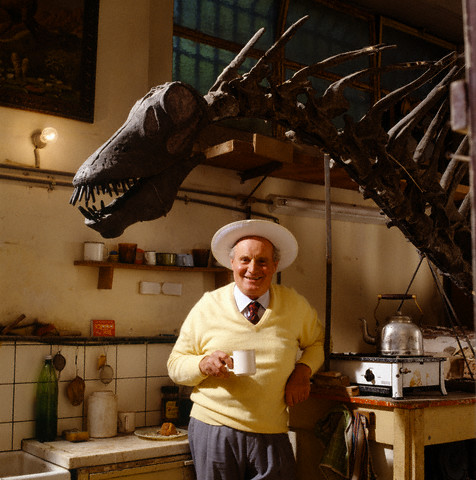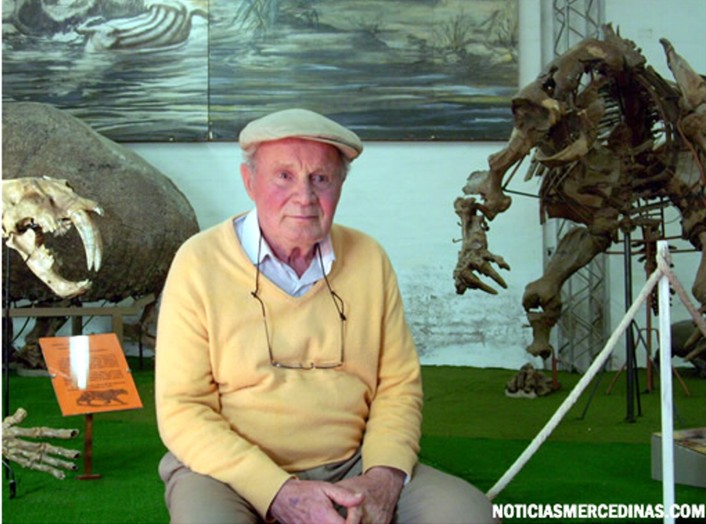José Fernando Bonaparte, Ph.D. (born June 14, 1928), is an Argentine paleontologist who discovered a plethora of South American dinosaurs and mentored a new generation of Argentine paleontologists like Rodolfo Coria. According to University of Pennsylvania paleontologist Peter Dodson, “almost singlehandedly he’s responsible for Argentina becoming the sixth country in the world in kinds of dinosaurs”
Bonaparte is the son of an Italian sailor. He was born in Rosario, Argentina, and grew up in Mercedes, Buenos Aires. Despite a lack of formal training in paleontology, he started collecting fossils at an early age, and created a museum in his home town. He later became the curator of the National University of Tucumán, were he was named Doctor Honoris causa in 1974, and then in the late 1970s became a senior scientist at the National Museum of Natural Sciences in Buenos Aires.
Discoveries
Southern diversity
The supercontinent of Pangea split into Laurasia in the north and Gondwana in the south during the Jurassic. During the Cretaceous, South America pulled away from the rest of Gondwana. The division caused a divergence between northern biota and the southern biota, and the southern animals appear strange to those used to the more northerly fauna. Bonaparte’s finds illustrate this divergence, and caused paleontologist Robert Bakker to dub him the “Master of the Mesozoic“.
In South America, the titanosaurs developed armor and flourished, while the sauropods of the northern continent were dying out and being replaced by vast herds of hadrosaurs; the carnivorous theropods were represented by abelisaurs and strange-looking dinosaurs like the horned, short-armed, and stub-nosed Carnotaurus. There are indications that a land bridge reunited North and South America during the Late Cretaceous because titanosaurs have been discovered as far north as Utah and duck-bills as far south as Patagonia.
List of dinosaurs named
- Abelisaurus comahuensis (1985, with Novas), a carnivorous theropod, like Allosaurus.
- Agustinia ligabuei (1998, formerly Augustia), a sauropod like Brachiosaurus with spinal plates like Stegosaurus
- Alvarezsaurus calvoi (1991), the original and most primitive member of the hard-to-classify bird-like alvarezsaurids.
- Amargasaurus cazaui (1991, with Salgado), a diplodocid like Diplodocus, with spines (and a sail?) running down its back.
- Andesaurus delgadoi (1991, with Calvo), a titanosaurid and one of the largest dinosaurs.
- Argentinosaurus huinculensis (1993, with Coria), a titanosaurid and one of the largest dinosaurs.
- Argyrosaurus superbus (1984), a titanosaurid and one of the largest dinosaurs.
- Carnotaurus sastrei (1985), a bull-headed ceratosaurian carnivore.
- Coloradisaurus brevis (1978, formerly Coloradia), an early (Triassic) sauropodomorph.
- Dinheirosaurus lourinhanensis (1999, with Octávio Mateus), Portuguese sauropod
- Guaibasaurus candelariensis (1998, with Ferigolo), a primitive saurischian.
- Kritosaurus australis (1984, with Frenchi, Powell and Sepúlveda), the most well known South American duck-bill.
- Lapparentosaurus madagascariensis (1986), a sauropod.
- Ligabueino andesi (1996), a small ceratosaurian.
- Mussaurus patagonicus (1979, with Vince), an early (Triassic) sauropodomorph known only from eggs and tiny baby skulls.
- Noasaurus leali (1980, with Powell), a ceratosaurian that was thought to have a Deinonychus-like hind claw (but the claw belongs on the hand).
- Patagopteryx (1992) – the world’s most primitive flightless true bird
- Piatnitzkysaurus floresi (1979), a tetanuran theropod.
- Pterodaustro (1970), a pterosaur.
- Rayososaurus agrioensis (1996), a rebbachisaurid sauropod.
- Riojasaurus incertus (1969), an early (Triassic) sauropodomorph.
- Saltasaurus loricatus (1980, with Powell), an armored titanosaurid.
- Velocisaurus unicus (1991), a ceratosaurian built for speed.
- Volkheimeria chubutensis (1979), a sauropod.
Source: Wikipedia.



 May 3rd, 2013
May 3rd, 2013  Riffin
Riffin 

 Posted in
Posted in  Tags:
Tags: 